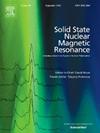Dynamic nuclear polarization of TEMPO radical cross conjugated with a thioanisole scaffold
IF 2.4
3区 化学
Q4 CHEMISTRY, PHYSICAL
引用次数: 0
Abstract
Nuclear magnetic resonance (NMR) spectroscopy is an important technique for molecular structure determination but is inherently limited by its low sensitivity. Recently, the Dynamic nuclear polarization (DNP) technique has emerged as a solution to overcome the intrinsic low sensitivity of NMR spectroscopy by transferring polarization from the unpaired electron spins to nuclear spins under microwave irradiation, achieving a theoretical sensitivity enhancement of up to 658-fold for the detection of 1H. In this study, we report the synthesis and characterization of a series of TEMPO(2,2,6,6-tetramethylpiperidine-1-oxyl)-based radicals functionalized with a thioanisole scaffold, designed to facilitate self-assembled monolayers on gold surfaces. The radicals were investigated using electron paramagnetic resonance (EPR) and DNP NMR spectroscopy. These radicals demonstrated properties consistent with the standard TEMPO while maintaining stability and functionality. At 10 mM concentration in TCE (1,1,2,2-tetrachloroethane), Radical-Imine-1 yielded a DNP enhancement factor of 3.2 for 1H nuclei and that of standard TEMPO is around 2.8 at 14.1 T. Relaxation measurements revealed that longitudinal relaxation times (T1) decreased with radical concentration, while transverse relaxation times (T2) remain largely unaffected, indicating minimal perturbation from paramagnetic quenching. The structural stability and surface-binding potential of the methyl thiol group make these derivatives suitable for surface-based DNP applications.

硫代苯甲醚支架交联TEMPO自由基的动态核极化
核磁共振波谱是测定分子结构的重要技术,但其灵敏度低是其固有的局限性。近年来,动态核极化(DNP)技术的出现克服了核磁共振波谱固有的低灵敏度,通过在微波照射下将未对电子自旋的极化转移到核自旋上,使探测1H的理论灵敏度提高了658倍。在这项研究中,我们报道了一系列TEMPO(2,2,6,6-四甲基哌啶-1-氧基)基自由基的合成和表征,这些自由基被硫代苯甲醚支架功能化,旨在促进金表面的自组装单层。采用电子顺磁共振(EPR)和DNP核磁共振光谱对自由基进行了研究。这些自由基表现出与标准TEMPO一致的特性,同时保持稳定性和功能性。在10 mM浓度的TCE(1,1,2,2-四氯乙烷)中,radical -亚胺-1对1H原子核的DNP增强因子为3.2,而标准TEMPO在14.1 t时的DNP增强因子约为2.8。弛豫测量显示,纵向弛豫时间(T1)随着自由基浓度的增加而减少,而横向弛豫时间(T2)基本不受影响,表明顺磁淬火的扰动最小。甲基巯基的结构稳定性和表面结合潜力使这些衍生物适合于基于表面的DNP应用。
本文章由计算机程序翻译,如有差异,请以英文原文为准。
求助全文
约1分钟内获得全文
求助全文
来源期刊
CiteScore
5.30
自引率
9.40%
发文量
42
审稿时长
72 days
期刊介绍:
The journal Solid State Nuclear Magnetic Resonance publishes original manuscripts of high scientific quality dealing with all experimental and theoretical aspects of solid state NMR. This includes advances in instrumentation, development of new experimental techniques and methodology, new theoretical insights, new data processing and simulation methods, and original applications of established or novel methods to scientific problems.

 求助内容:
求助内容: 应助结果提醒方式:
应助结果提醒方式:


